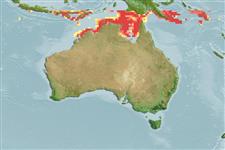Environment: milieu / climate zone / depth range / distribution range
বাস্তুসংস্থান
সামুদ্রিক তলদেশ বিহারী; গভীরতার পরিসীমা 10 - 62 m (Ref. 6871). Deep-water; 8°S - 16°S
Eastern Indian Ocean and Southwest Pacific: northern Australia, southern New Guinea and eastern Indonesia.
Length at first maturity / আকৃতি / ওজন / Age
Maturity: Lm 20.3, range 18 - 22 cm
Max length : 45.0 cm TL পুরুষ/ লিঙ্গ অনিধর্ারিত ; (Ref. 9840)
Found offshore on continental shelf and feeds on bony fishes and crustaceans. Litters of 1-3 pups, born at 12-14 cm WD (Ref. 114953). Ovoviviparous (Ref. 50449)
Life cycle and mating behavior
পরিপক্কতা | প্রজনন | ডিম ছাড়া | ডিমসমূহ | ডিম্বধারন ক্ষমতা | শুককীট
Ovoviviparous (Ref. 205). Distinct pairing with embrace (Ref. 205).
Last, P.R. and J.D. Stevens, 1994. Sharks and rays of Australia. CSIRO, Australia. 513 p. (Ref. 6871)
IUCN Red List Status (Ref. 130435: Version 2024-2)
Threat to humans
Harmless
Human uses
মৎস্য: আকর্ষণবিহীণ
হাতিয়ার
Special reports
Download XML
ইন্টারনেট সুত্র
Estimates based on models
Preferred temperature (Ref.
123201): 27.1 - 28.7, mean 28 °C (based on 140 cells).
Phylogenetic diversity index (Ref.
82804): PD
50 = 0.5039 [Uniqueness, from 0.5 = low to 2.0 = high].
Bayesian length-weight: a=0.01096 (0.00350 - 0.03435), b=3.12 (2.87 - 3.37), in cm total length, based on LWR estimates for this (Sub)family-body shape (Ref.
93245).
ট্রফিক পর্যায়ে (Ref.
69278): 3.4 ±0.3 se; based on size and trophs of closest relatives
স্থিতিস্থাপক (Ref.
120179): নিম্ন/ , সর্বনিম্ন প্রজন দ্বিগুনের সময় ৪.৪-১৪ বৎসর (Assuming fecundity<100).
Fishing Vulnerability (Ref.
59153): Low to moderate vulnerability (35 of 100).
